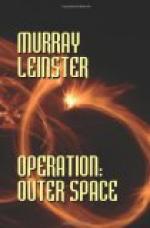The ship took off two hours after the broadcast. Part of that time was taken up with astrogational conferences with astronomers on Earth. Cochrane had this conference taped for the auxiliary broadcast-program in which the audience shared the problems as well as the triumphs of the star-voyagers. Cochrane wanted to get back to Earth. So far as television was concerned, it would be unwise. The ship and its crew would travel indefinitely without a lack of sponsors. But for once, Cochrane agreed entirely with Holden.
“We’re heading back,” he told Babs, “because if we keep on, people will accept our shows as just another superior kind of escape-entertainment. They’ll have the dream quality of ‘You Win a Million’ and the lottery-shows. They’ll be things to dream about but never to think of doing anything about. We’re going to make the series disappointingly short, in order to make it more convincingly factual. We won’t spin it out for its entertainment-value until it practically loses everything else.”
“No,” said Babs. She put her hand in his. She’d found it necessary to remind him, now and then.
So the ship started home. And it would not return direct to Earth—or Lunar City—for a very definite reason. Cochrane meant to have all his business affairs neatly wrapped up before landing. They could get another show or two across, and some highly involved contracts could be haggled to completion more smoothly if one of the parties—Spaceways, Inc.—was not available except when it felt like being available. The other parties would be more anxious.
So the astrogation-conference did not deal with a direct return to Earth, but with a small sol-type star not too far out of the direct line. The Pole Star could have been visited, but it was a double star. Cochrane had no abstract scientific curiosity. His approach was strictly that of a man of business. He did the business.
There was, of course, a suitable pause not too far from the second planet—the planet of the shaggy beasts. They put out a plastic balloon with a Dabney field generator inside it. It would float in emptiness indefinitely. The field would hold for not less than twenty years. It would serve as a beacon, a highway, a railroad track through space for other ships planning to visit the third world now available to men. Ultimately, better arrangements could be made.
Jones was already ecstatically designing ground-level Dabney field installations. There would be Dabney fields extending from star to star. Along them, as along pneumatic tubes, ships would travel at unthinkable speeds toward absolutely certain destinations. True, at times they could not be used because of the bulk of planets between starting-points and landing-stations. But with due attention to scheduling, it would be a simple matter indeed to arrange for something close to commuters’ service between star-clusters. He explained all this to Cochrane, with Holden listening in.




